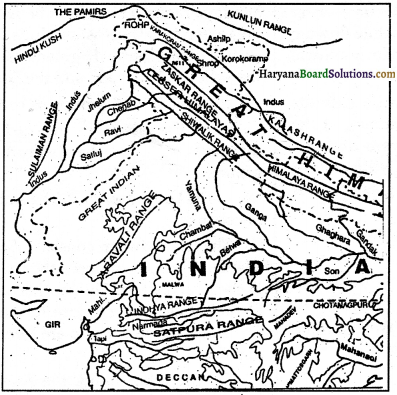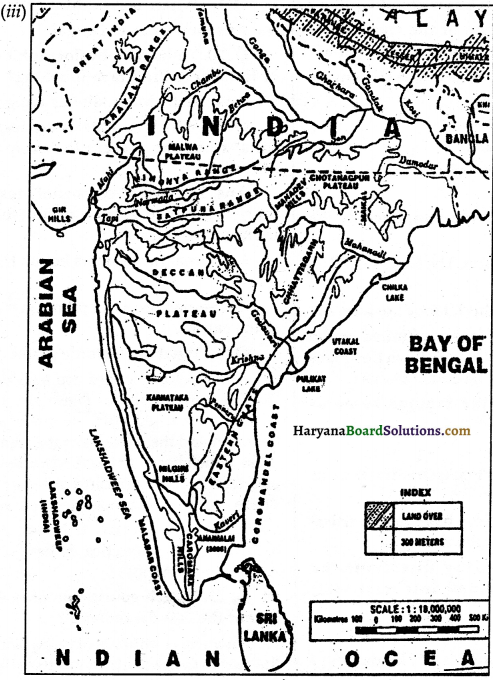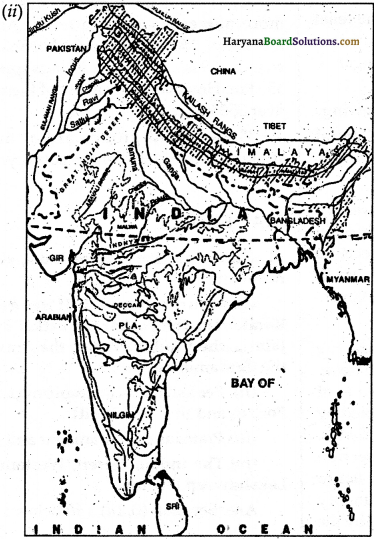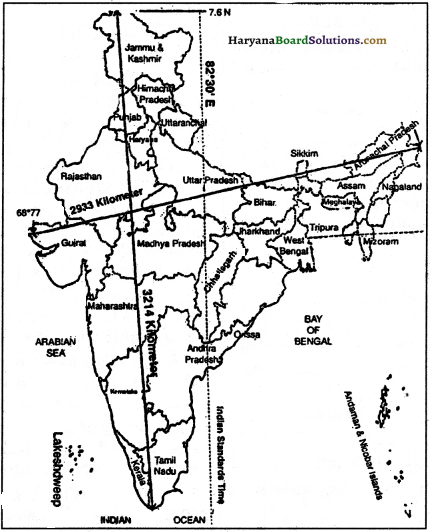HBSE 9th Class Social Science Solutions Geography Chapter 3 Drainage
Haryana State Board HBSE 9th Class Social Science Solutions Geography Chapter 3 Drainage Textbook Exercise Questions and Answers.
Haryana Board 9th Class Social Science Solutions Geography Chapter 3 Drainage
HBSE 9th Class Social Science Geography Drainage TextBook Questions and Answers
Geography Chapter 3 Drainage Question Answer HBSE 9th Class Question 1.
Choose the right answer from the four alternatives given below:
(i) Which one of the following describes the drainage patterns resembling the branches of a tree?
(a) Radial
(b) Dendritic
(c) Centrifugal
(d) Trellis
Answer:
(b) Dendritic
(ii) In which of the following states is the Wular lake located?
(a) Rajasthan
(b) Uttar Pradesh
(c) Punjab
(d) Jammu&Kashmir
Answer:
(d) Jammu&Kashmir
(iii) The river Narmada has its source at:
(a) Satpura
(b) Brahmagir
(c) Amarkantak
(d) Slopes of the Western Ghats
Answer:
(c) Amarkantak
(iv) Which one of the following lakes is a saltwater lake?
(a) Sambhar
(b) Dal
(c) Wular
(d) Gobind Sagar
Answer:
(a) Sambhar
(v) Which one of the following is the longest river of Peninsular India?
(a) Narmada
(b) Amravati
(c) the Godavari
(d) Mahanadi
Answer:
(c) the Godavari
![]()
(vi) Which among the following rivers flow through a rift valley?
(a) Damodar
(b) Tungabhadra
(c) Krishna
(d) Tapi
Answer:
(d) Tapi
Class 9 Social Science Drainage HBSE Question 2.
Answer the following questions:
(i) What is meant by a water divide? Give an example.
Answer:
The upland that separates two drainages, basins is called the water divide. Examples: any elevated area, the mountain.
(ii) Which is the largest river basin in India?
Answer:
The Ganga Basin.
(iii) Where do the rivers Indus and the Ganga have their origin?
Answer:
Mansarovar Lake.
(iv) Name the two headstreams of the Ganga. Where do they unite to form the Ganga?
Answer:
The two headstreams Of tire Ganga are the Alaknanda and Bhagirathi. They unite at Devprayag to form the Ganga.
(v) Why does the Brahmaputra, in its Tibetan part have less silt, despite a longer course?
Answer:
Despite a longer course, the Brahmaputra, in its Tibetan part have- less silt because it receives very little volume of water here.
(vi) Which two peninsular rivers flow through trough? What features do they form while entering the sea?
Answer:
1. The Narmada and
2. The Tapi are the two peninsular rivers that flow.
through trough. On their way to the sea, they create many picturesque locations. The ‘Marble rocks’ and the ‘Dhualdhar falls’ constitute a remarkable feature.
(vii) State some economic benefits of rivers and lakes.
Answer:
The five economic benefits of rivers and lakes Can be stated as under:
1. Water from lakes and rivers helps develop hydel power.
2. They help develop the tourism industry.
3. They help in providing irrigation for agriculture.
4. They provide the water necessary for human life.
5. For industries and their development, water becomes a raw material, example it provides coolant
![]()
Class 9th Geography Chapter 3 Question Answer HBSE Question 3.
Below are given names of a few lakes of India. Group them under two categories-natural and man-made.
(a)Wular
(b) Dal
(c) Nainital
(d) Bhimtal
(e) Gobind Sagar
(f) Loktal
(g) Barapanl
(h) Chilka
(i) Sambhar
(j) Rana Prtap Sagar
(k) Ñzam Sagar
(l) Pulicat
(m) Nagarl una Sagar
(n) Hirakund
Answer:
Natural:
1. Wular
2. Dai
3. Nainital
4. Bhiniial
5. Sambhar
6. Pulicat
7. Loktal
8. Chilka
9. Barapani
Man-made:
1. Gobind Sagar
2. Rana Pratap Sagar
3. Nizam Sagar
4. Nagarjun Sagar
5. Hirakud.
Drainage Chapter HBSE 9th Class Question 4.
Discuss die significant differences between die Himalayan and the Peninsular rivers.
Answer:
The Himalayan Rivers:
1. These are the rivers that rise in the snow-covered mountains as such they flow throughout the year.
2. The Himalayan rivers flow in leveled Northern plains. Hence these are more useful in navigation and irrigation.
3. These rivers bring fertile alluvium with them.
4. Canals can be easily dug to use the water of these rivers for irrigation.
The Peninsular Rivers:
1. These rivers rise from the mountains in the Deccan which are not snow-covered.
2. These rivers flow On the uneven rocky surfaces. Hence these are not very suitable for navigation or irrigation.
3. These do not bring enough alluvium with them. The currents in these rivers are so swift that the deposition activity, is negligible.
4. The banks of these rivers are high and the terrain also rocky. Hence in these rivers canals cannot be dug.
![]()
Question 5.
Compare the east flowing and the west-flowing rivers of the peninsular plateau.
Answer:
East Flowing Rivers:
1. The east-flowing rivers move to-wards the east- direction.
2. The Mahanadi, the Godavari, the Krishna and the Kaveri are the east flowing rivers of peninsular India while Yamuna and Ganga also move eastward in northern India.
3. These rivers fall into the Bay of Bengal.
4. Most of these rivers make deltas at their mouth.
5. The east-flowing rivers have a developed tributary system.
6. The east-flowing rivers generally do not flow through very deep channels.
West flowing Rivers:
1. The west-flowing rivers move in the west direction.
2. Narmada and Tapi are the important west-flowing rivers of Peninsular India. Indus is the west-flowing river of northern India.
3. These rivers fall in the Arabian sea.
4. These rivers enter the sea through estuaries. These tributaries are comparatively large in size.
5. The west-flowing rivers are devoid of a developed tributary system. These tributaries are small in size.
6. The west-flowing rivers flow in throughout or a funnel like narrow but deep channels.
Question 6.
Why are rivers important for the country’s economy?
Answer:
Rivers provide the most productive agricultural lands in the country. The Ganga, the Kaveri, and other deltas have traditionally been rice-growing areas. Irrigation from rivers has been the backbone of the development of Indian agriculture. Industrial development has flourished along rivers as many industrial processes rely on water as raw material, as a coolant, and for the generation of hydroelectricity. The rivers provide primary channels of inland transportation which are necessary for the country’s economy.
HBSE 9th Class Social Science Geography Drainage Important Questions and Answers
Question 1.
Where trom the Brahmaputra originates?
Answer:
From Tibet.
Question 2.
In which direction does the Brahmaputra flow?
Answer:
The Brahmaputra flows in an eastward direction parallel to the Himalayas.
Question 3.
Whaf does the Brahmaputra do in Namcha Barwa?
Answer:
The Brahmaputra reaching Namcha Barwa takes a U-tum and enters India in Arunachal Pradesh.
Question 4.
What is a river basin?
Answer:
A river basin is meant by the area which is drained by a single river system. This an also known as a drainage basin.
![]()
Question 5.
Name two saltwater lakes on the eastern coast of India.
Answer:
1. The Chilka-in Orissa.
2. The Pulicat-in Tamil Nadu.
Question 6.
In which states does the Brahmaputra flow in India?
Answer:
1. Arunachal Pradesh
2. Assam.
Question 7.
By which name the Brahmaputra is known in Tibet?
Answer:
Tsangpo.
Question 8.
Name the city located on the water divide between the Indus and Ganga.
Answer:
Ambatal
Question 9.
By which name the mainstream of Ganga is known in Bangladesh?
Answer:
The Padma.
Question 10.
When is the Ganga known as Tainuna?
Answer:
In Bangladesh whori the Brahmaputra joins the Ganga, it is known as Jamuna.
Question 11.
Where does the Jhelum fall into the Indus?
Answer:
A little over Mithankot.
Question 12.
What is meant by the dendritic pattern of streams?
Answer:
The dendritic pattern of streams indicates the streams resemble like the branches of a tree.
Question 13.
What is meant by the trellis 1
Answer:
Trellis indicates the situation where the tributaries join the mainstream at the right angles.
Question 14.
What is meant by a braided stream?
Answer:
The braided stream is a channel of a stream that has a large island within it.
Question 15.
What is meant by island drainage?
Answer:
Island drainage refers to die rivers not reaching an ocean. Instead, they fall into a sea or lake within the land.
![]()
Question 16.
From which glacier does the Yamuna originate?
Answer:
Yamunotri.
Question 17.
Name the largest peninsular river of India.
Answer:
The Godavari.
Question 18.
Name the tributaries of die river Krishana.
Answer:
1. The Tungabhadra
2. The Koyna,
3. The Ghatprabha
4. The Musi
5. The Bhima.
Question 19.
Name the states which fall, into the drainage basin of the Narmada
Answer:
1. Maharashtra
2. Karnataka
3. Andhra Pradesh.
Question 20.
Which river originates from the Brahmagir range of the Western Ghats?
Answer:
The Kaveri.
Question 21.
Why are the peninsular rivers seasonal?
Answer:
They are seasonal because their flow depends on due rainfall.
The Himalayan and the Peninsular Rivers.
Himalayan Rivers
| River | Source | Total length (Km) | Area Drained (Sq. Km) | Important Tributaries |
| Indus | Tibet, 100 km near of Mansarovar Lake, ht. 5000m | 2900 709 (in India) | 1,17,844 in India 3,00,000 | Zaskar, Shyok, Jhelum, Chenab, kavi, Beas, Satluj |
| Ganga Two head-streams (i) Alaknanda – (ii) Bhagirathi | Ht 7800m Ht. 6600m | 2070 2490 | 9,51,600 8,28,200 | Yamuna, Ghaghara, Gandak, Kosi, i$on, Chambal, Betwa |
| Brahmaputra | About 100 km S.W. of mansarovar Ht. 5,150 m | 2900 (In India) | 5.80.0 (in India) 2.85.000 | Raja Tsangpo, Lhotse, Subansiri, Tistaj Torsa, Dihang |
Peninsular Rivers
| River | Source | Total length (Km) | Area Drained (Sq. Km) | Important Tributaries |
| Narmada | Rises near AmarkantakinMP at 1057 m | 1300 | 93,080 | Short tributaries zone more than 200m. Burhner Baiyar, Dudhi, Tawa,, Hirari, etc |
| Tapi | Rises in Betual district | 792 | 64,750 | Puma, Betul, Lavda etc |
| Mahanadi | Raipur district, Chhattis- Subamarekha garh ht. 442 m | 885 | 1,92,000 | Brahmàni,, Baitarm, |
| Godavari | Nashik dist, of Maharashtra, ht. 1067 m | 1500 | 3,24,000 | Puma, Wardha, Pranhita, Manjra, Wainganga, Penganga, etc. |
| Krishna | Near Mahabale- shwar, Mahara-shtra | 1400 | 2,60.000 | Koyna, Panch Ganga, Dudhgariga, Tunabhadra. Musi, Bhima, etc. |
| Kaveri | Brahmagir Hills/ ht. 1,341 m | 765 | 7Z000 | Amravati, Shiva, etc. |
Question 21.
Point out the prominent features of the Ganga-Brahmaputra delta.
Answer:
1. It is the largest delta of die world.
2. It is one of the most fertile areas of the world.
3. It is a triangular-shaped area.
4. It is a well-watered area.
5. The lower part of this delta is marshy.
6. Mangroves are found only in this place of the whole of India.
Question 22.
How Would you differentiate between a glacier and a river?
Answer:
The Glacier
1. Glaciers are in solid form.
2. Glaciers look like a mountain of ice.
3. Glaciers move very slowly.
4. The movement of a glacier is not discernible.
The River:
1. Rivers are in liquid form.
2. Rivers may be seen flowing.
3. Rivers move with a greater speed.
4. The movement of a river is easily discernible.
Question 23.
How the lakes are formed?
Answer:
1. Lakes are formed in the mountainous area when the glaciers block the valleys and a large amount of water is collected in that place.
2. The violent movements of the earth, like earthquakes, also create lakes when the depressions formed on the crust of the earth are filled with rainwater.
3. Human beings also form lakes, for various purposes.
![]()
Question 24.
What is meant by the Indus water treaty?
Answer:
Indus water treaty is a treaty between India and Pakistan. This treaty is about the- sharing of the waters of the Indus system. According to this treaty, India can use only 20% of the total of water carried by the Indus river system.
Question 25.
Name the states through which the river Mahanadi flows.
Answer:
The river Mahanadi flows through three states of India:
1. It originates in Chattisgarh
2. If falls in the Bay of, Bengal in Orissa.
3. Hence it flows through Chattisgarh and Orissa Only.
Question 26.
Why are the rivers considered the lifelines of human civilization?
Answer:
Rivers are undoubtedly the lifelines of human civilization. All the early: civilizations whether in India, Mesopotamia, Egypt or in China, flourished in the river valleys. The Harappan culture of India flourished in the Indus valley. The Egyptian civilization flourished in the Nile valley and the Mesopotamian in the valleys of the Tigris and Euphrates. It is a well-known fact that rivers provide us with water. Without water, one can not imagine life. Hence it is a very natural tendency to stay and live by the sides of the river and their nearby areas. So that water heed for drinking and cultivation etc, could be fulfilled easily.
Question 27.
What do you mean by the drainage?
Answer:
Drainage is an outcome of the evolutionary process of the broad relief features of the country. It is meant by the river system of an area.
Question 28.
Answer the following questions:
(i) Three major rivers Originating beyond the Himalayas.
(i) The source area of these rivers.
(iii) Point out the feature formed by these rivers.
Answer:
(i) Three major rivers originating beyond tire Himalayas are:
1. The Indus
2. The Satluj
3. The Brahmputra
(ii) The source of the above rivers is Mansarovar near the Kailash.
(iii) Gorges, Canyons, U-shaped valleys
Question 29.
Write a few lines on the Ganga.
Answer:
The Ganga river originates from the Gangotri glacier in the Himalayas. After crossing through India and Bangladesh, it falls in the Bay of Bengal. It is of nearly 2500 km. length. The main tribu taries of Ganga are the Yamuna, Gomut, Ghagra, gandak and Kosi. The southern tributaries of the Ganga are Son. Chambel, Betwa and Kosi.
![]()
Question 30.
Which are the important peninsular rivers of India?
Or
Give a brief account of the different peninsular rivers of India.
Answer:
The Narmada:
If rises from Amarkantak in Madhya Pradesh. It flows west-southward in a trough for a distance about 1300 km. The Narmada gorge in the marble rocks of Madhya Pradesh is very famous for its beauty.
The Tapi:
It rises from the Betul district of Madhya Pradesh. It flows in a trough parallel to the Narmada. However, it is smaller in size than that of the Narmada:
The Godavari:
It is also known as the Dakshin Ganga and Vridha Ganga. It is the largest among the peninsular rivers of India. It rises in the Nashik district of Maharashtra. Its length is about 15000 km. It drains into the Bay of Bengal.
The Mahanadi:
It rises ill Chattisgarh and flows through Orissa and reaches the Bay of Bengal.
The Krishna:
It rises from the spring near Mahabaleshwar. If flows for nearly about 1400 km. Its drainage basin is shared by Maharashtra, Karnataka and Andhra Pradesh.
The Kaveri:
It rises in the Brahmagir ranges of the Western Ghats. If flows over 800 km. Near Kaveripatnam, it reaches the Bay of Bengal.
Question 31.
What is the reason of the water pollution? How the pollution level can be reduced?
Or
Suggest some measures to reduce the pollution of water.
Answer:
Water pollution indicates that the water is not pure and safe for health. Today, many factors are causing water pollution; It is very dangerous for health as well as for tire environment. The large number of the dead fishes found in the Yamuna at Agra proved it.’ Factories, especially the chemical industries, paper mills, sugar mills, tanneries etc are causing the water to be polluted. The disposal of sewage of urban areas into the rivers also leads to this pollution. As for example, the Najafgarh Nala in Delhi may be taken.
Question 32.
What is meant by a lake? Introduce some of the important lakes of India.
Or
How are the lakes useful for us?
Or
Point out the importance of lakes.
Answer:
A large low-lying depression in the earth filled with water is called a lake. A lake may be natural or artificial that is, human-made Lakes may be in the hill areas as well as in the plain. Importance of the Lakes
1. Lakes help us in drainage.
2. These are the beauties attracting tourists.
3. These are important for nature and protecting natural beauty.
4. Lakes are also important for the economy of a country.
5. They are used for boating and fishing.
6. They provide opportunities for recreation.
Reduction in water (low due to ever-increasing abstraction of water for irrigation from the river Ganga through canals.
![]()
Question 33.
Point out the achievements of the Ganga Action Plan.
Answer:
1. Mainly 260 schemes have been launched in the Ganga Action Plan.
2. Nearly 45 of them have been completed with positive results.
3. Trees have been planted in badly, eroded portions to check the dams reputed in the upper reaches of the river.
4. The interception and diversion of several major drains carrying sewage and industrial wastes to the river Ganga have been completed in several cities like Varanasi Kanpur and Patna.
5. It has reduced the pollution level substantially.
6. Turtles and the Gangetic dolphins which had disappeared for several years, reappeared in Varanasi and other places.,
7. All of the above points indicate the recovery of the health of the Ganga.
Hence though the Ganga Action Plan has miles to go; it has no doubt achieved several landmark achievements.
Question 34.
Give an account of the drainage of the surface water of India.
Answer:
1. Two third of the total surface water of India drains into the Bay of Bengal.
2. About 20% of the surface water drains into the Arabian Sea.
3. A little less than 10% drain to form part of the inland drainage of the Rajasthan desert and Aksai Chain.
4. Nearly 1% drains to the Andaman Sea through the tributaries of the Irrawaddy in- Myanmar.
Question 35.
Write a detailed note on the Indus River System.
Answer:
The river Indus rises in Tibet, near Lake Mansarovar. Flowing west, it enters India in the Ladakh district of Jammu and Kashmir through a picturesque gorge. Several tributaries, the Zaskar, the Shyok and the Huzana, join it in this region. It flows through Baltistan and Gilgit and emerges from the mountains at Attack.
The famous five rivers of Punjab-the Satluj; the Beas, the Ravi, the Chenab, and the Jhelum-enter.the Indus a little above Mithankol in Pakistan. Beyond this, the Indus flows southwards eventually reaching the Arabian Sea, east of Karachi. The total length of the river is about 2900Jem, ranking it among the longest rivers of the world. A little over a third of the Indus basin is located in India in the states of Jammu and Kashmir, Himachal Pradesh, and Punjab and the rest is in Pakistan.
Question 36.
What do you know about the Brahmaputra rivers System?
Answer:
The Brahmaputra rises in Tibet east of Mansarovar lake very close to the sources of the Indus and the Satluj. In Tibet, it is called the Tscmgpo. It is slightly longer than the Indus, and most of its course lies outside India..It flows eastwards parallel to the Himalayas to its south. On reaching the mountain peak the Namcha Barwa (7757 m), it takes a ‘U’ turn and enters India in Arunachal Pradesh through a gorge.
Here it is called the Dihang and it is joined by the Dibang, the Lohit the Kenula and many other tributaries to form the Brahmaputra in Assam. In Tibet the river carries a smaller volume of water and less silt as if is a comparatively dry area. In India it passes through a region, which receives a huge amount of rainfall. As a result, the river carries a large volume of water and a considerable amount of silt. The Brahmaputra has a braided channel in its entire length in Assam, with many riverine islands.
Objective Type Questions
Question 1. Put (✓) before the correct sentences and (✗) before the incorrect sentences.
(i) Of the 260 schemes of the Ganga Action plan, 45 have been completed with a positive result
(ii) The Kaveri raises from Amarkantak,
(iii) India has comparatively few natural lakes.
(iv) Over two-thirds of the surface water of India drains into the Bay of Bengal.
(v) Aksai Chin is in Uttaranchal.
(vi) The Krishana is famous as the Vridha Ganga.
(vii) Chilka lake is a large lagoon.
(viii) The rising pollution of Ganga became a cause of concern during the 1970 and 1980s.
Answer:
(i) ✓
(ii) ✗
(iii)✓
(iv) ✓
(v) ✗
(vi)✗
(vii) ✓
(viii) ✓
![]()
Question 2.
Fill in the balnks with suitable words.
(i) The Mahanadi rises from ………….
(ii) The Krisha flows for about ……………. Km.
(iii) Where the sweet water mixes with the salt water of the ocean is known as ……………
(iv) The ………….. basin is shared by Kerala, Karnataka, and Tamil Nadu.
(v) Aksai chin is in ………..
Answer:
(i) Chattisgarh
(ii) 1400
(iii) estuaries
(iv) Kaveri
(v) Jammu and Kashmir.
Question 3.
Match the following two lists.
| List I | List II |
| (i) Bhima | Farakka |
| (ii) Godavari | Krishna |
| (iii) Rajasthan | Nashik |
| (iv) Kaveri | 800 Km. |
| (v) Loktak | In land drainage |
| (vi) Ganga | Manipour |
Answer:
| List I | List II |
| (i) Bhima | Krishna |
| (ii) Godavari | Nashik |
| (iii) Rajasthan | In land drainage |
| (iv) Kaveri | 800 Km. |
| (v) Loktak | Manipour |
| (vi) Ganga | Farakka |
Question 4.
Choose the right answer from the four alternatives given below:
The river Indus rise from the following:
(a) Mansa rover
(b) Gangotri
(c) Nasik
(d) Mahabaleswar.
Answer:
(a) Mansa rover
(ii) The Ganga is also known as:
(a) Krishana
(b) Bhagirathi
(c) Narmada
(d) Kaveri.
Answer:
(b) Bhagirathi
![]()
(iii) The following is a peninsular river
(a) The Ganga
(b) The Tapi
(c) The Indus
(d) TheBrahmpaputra
Answer:
(b) The Tapi
(iv) The following is the largest peninsular river:
(a) Mahanadi
(b) Krishna
(c) Godawari
(d) Narmada.
Answer:
(c) Godawari
(v) The following is the range from where the river Tapi rises:
(a) Satpura
(b) Aravalli
(c) Vindhya
(d) None of these.
Answer:
(a) Satpura
HBSE 9th Class Social Science Solutions Geography Chapter 3 Drainage Read More »




